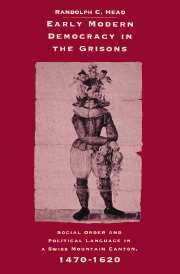 Early Modern Democracy in the Grisons
Early Modern Democracy in the Grisons Book contents
- Frontmatter
- Contents
- List of illustrations
- List of tables
- Acknowledgments
- Note on languages, orthography, and translations
- Abbreviations
- INTRODUCTION: Social order, politics, and political language in Graubünden, 1470–1620
- 1 Communalism and other political models in Europe and in Graubünden
- 2 Graubünden to 1520: geography, society, history
- 3 Local practice and federal government in the Freestate
- 4 From consolidation to communal politics: the Freestate, ca. 1530–1580
- 5 Elite power and popular constraint in sixteenth-century Rhaetia
- 6 Reform, communal action and crisis, ca. 1580–1639
- 7 Political language and political cosmology during the crisis years
- CONCLUSION: Democracy in early modern Graubünden
- Bibliography
- Index
- CAMBRIDGE STUDIES IN EARLY MODERN HISTORY
4 - From consolidation to communal politics: the Freestate, ca. 1530–1580
Published online by Cambridge University Press: 14 October 2009
- Frontmatter
- Contents
- List of illustrations
- List of tables
- Acknowledgments
- Note on languages, orthography, and translations
- Abbreviations
- INTRODUCTION: Social order, politics, and political language in Graubünden, 1470–1620
- 1 Communalism and other political models in Europe and in Graubünden
- 2 Graubünden to 1520: geography, society, history
- 3 Local practice and federal government in the Freestate
- 4 From consolidation to communal politics: the Freestate, ca. 1530–1580
- 5 Elite power and popular constraint in sixteenth-century Rhaetia
- 6 Reform, communal action and crisis, ca. 1580–1639
- 7 Political language and political cosmology during the crisis years
- CONCLUSION: Democracy in early modern Graubünden
- Bibliography
- Index
- CAMBRIDGE STUDIES IN EARLY MODERN HISTORY
Summary
No republic under heaven today has such a form as among us in Rhaetia.
Johannes Fabricius, 1560Throughout the mid-sixteenth century, the Rhaetian Freestate enjoyed effective autonomy and constitutional stability. During this period, moreover, the exercise of power changed steadily to accommodate both institutional maturation and slower developments in popular concepts of authority and legitimacy. The changes of 1524 to 1526 had brought about new preconditions for political life, but practice took some time to catch up. Despite the incomplete triumph of communal politics, however, Rhaetia was unique in that communal principles continued to evolve there in the context of a functioning state. Although political and ideological change in the Freestate continued to reflect multiple, sometimes conflicting tendencies, we can for the sake of clarity identify three phases of development after the 1520s, each characterized by its own dominant trends. First came a period of political consolidation from the mid-1520s to the mid-1540s; second was a period of conflict among elite factions from the 1540s on; the third phase, from the 1560s to the end of the century, saw increasing political activity by the communes in opposition to the new elite.
During the first phase, retrenchment after the internal and external storms of the 1520s dominated the course of politics. Domestically, the Ilanz Articles and the Bundesbrief required adjustments from the episcopal castle to the humblest hamlet.
- Type
- Chapter
- Information
- Early Modern Democracy in the GrisonsSocial Order and Political Language in a Swiss Mountain Canton, 1470–1620, pp. 118 - 134Publisher: Cambridge University PressPrint publication year: 1995


